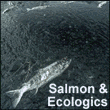forum
library
tutorial
contact

Oregon's Bonneville Hatchery
by Chris WoolstonVIA Magazine, November/December 2011
|
the film forum library tutorial contact |

|
Oregon's Bonneville Hatchery
by Chris WoolstonVIA Magazine, November/December 2011 |
Get up close to salmon, steelhead, and one massive old sturgeon at the Bonneville Hatchery in Oregon's scenic Columbia River Gorge.
 The world's most famous white sturgeon is too mature to put on a show for cameras. Now well into his 70s, Herman the Sturgeon mostly drifts about his pond with prehistoric grace, occasionally sticking his whiskered face up against the glass of his underwater viewing area to greet some of the half million people who visit his home each year.
The world's most famous white sturgeon is too mature to put on a show for cameras. Now well into his 70s, Herman the Sturgeon mostly drifts about his pond with prehistoric grace, occasionally sticking his whiskered face up against the glass of his underwater viewing area to greet some of the half million people who visit his home each year.
Herman -- he's 10 feet long, weighs 450 pounds, and has 1,000 friends on Facebook -- is the star and chief ambassador of the Bonneville Fish Hatchery, a 102-year-old facility near the mouth of Tanner Creek in the Columbia River Gorge. The hatchery, a place where the scents of giant firs and seasonal flowers (including nearly 100 rosebushes) mix with the expected smells of the fish business, raises millions of coho and chinook salmon and a few hundred thousand steelhead to be released in the Columbia and its tributaries.
Up close, Herman looks like a cross between a catfish and a dinosaur. From viewing platforms, visitors can watch him breach the surface, showing his gray back studded with a row of stubby white spines that seem to come from another era, specifically the Jurassic. It's no surprise to learn that these ancient creatures are true survivors. "Sturgeon can live out of the water for hours," says hatchery manager Greg Davis. "They are incredibly hardy." Herman shares his pond with several smaller sturgeons and a few hugely overweight rainbow trout, including one hunchbacked monster that looks as if it can barely keep its tail from dragging behind him.
Visitors can't feed Herman -- workers give him all the fish parts he can handle -- but anyone looking for a feeding frenzy can simply put a quarter in the pellet dispenser next to the pond of rainbow trout. These big, colorful fish thrash and jostle for the pellets, which smell a lot like Science Diet puppy food.
The rainbows are for entertainment; the tens of thousands of coho and chinook salmon that arrive at the hatchery each September through December are the real workhorses, recruited to lay the groundwork for the next generations.
They haven't forgotten how to make more fish. But in an age of well-equipped anglers and big dams -- including the Bonneville Dam next door -- the species need help from hatcheries, Davis says. The river's coho and chinook runs are both officially listed as threatened, one step less dire than endangered.
A few wild salmon do manage to make it through the spillways, turbines, and ladders at the dams to spawn in their home streams, but government hatcheries -- created in 1871 when President Ulysses S. Grant launched the U.S. Fish Commission -- help compensate for the ones that don't. It's a balancing act: Produce too many hatchery fish, and the remaining wild fish could get swamped. Produce too few, and the populationmight dwindle.
Following the rules of salmon life, the chinooks and cohos are in their last stage of life by the time they migrate back upriver to the hatchery's fish ladders. They'll stay in holding ponds until ready to spawn in late fall. But before they spawn, they die. Using humane shocks, workers stun, then kill the fish, strip the bright orange eggs from the females, and mix them in a bucket with milt from the males, a step that lures crowds in the spawning season. "That's probably the biggest draw at the hatchery," Davis says, tacitly confirming that Oregonians are the most fish-curious people on the planet. Visitors who miss a spawning session can watch the rearing process in a continuous video at the spawning center.
The eggs stay in clean, temperature-controlled incubators until they hatch into the fry that dart around the long raceways occupying much of the hatchery. Visitors can't climb up on the raceways, but they can peer over the edge to see what this place is all about: eager young fish who, with luck, might live long enough to return to the hatchery as adults, ready to do their job.
OTHER ENJOYABLE HATCHERIES
Bonneville is a great spot to learn about fish and see prime specimens: (541) 374-8393, www.dfw.state.or.us/resources/visitors/bonneville_hatchery.asp. Here are a few others.
AMERICAN FALLS HATCHERY American Falls, Idaho. Breeds catchable rainbow and brown trout. Features a picnic area and nature trails. (208) 226-2015, visitidaho.org/attraction/wildlife/american-falls-state-fish-hatchery.
DWORSHAK NATIONAL FISH HATCHERY Orofino, Idaho. Raises chinook salmon and steelhead for the long trip to the Pacific. Steelhead spawning from January through March is a main attraction. (208) 476-7242, fws.gov/dworshak.
EAGLE HATCHERY Eagle, Idaho. Rare Snake River sockeye salmon are bred at this site near Eagle Island State Park west of Boise. (208) 939-4114, fishandgame.idaho.gov/public/fish/?getpage=91.
ELK RIVER HATCHERY Port Orford, Ore. Produces steelhead and rainbow trout near the southern Oregon coast. One weekend each spring, kids can fish for the rainbows. (541) 332-7025, portorfordoregon.com/hatchery.html.
LOOKINGGLASS HATCHERY Elgin, Ore. Raises chinook salmon on a pretty stream in northeast Oregon's Blue Mountains. Visitors can view adult fish in ponds most of the summer. (541) 437-9723, www.dfw.state.or.us/resources/visitors/northeast.asp.
This article was first published in November 2011. Some facts may have aged gracelessly. Please call ahead to verify information.
Related Pages:
Bonneville Dam Fish Ladders: Once a Spawn a Time by Chris Woolston, VIA Magazine, 10/20/11
learn more on topics covered in the film
see the video
read the script
learn the songs
discussion forum
